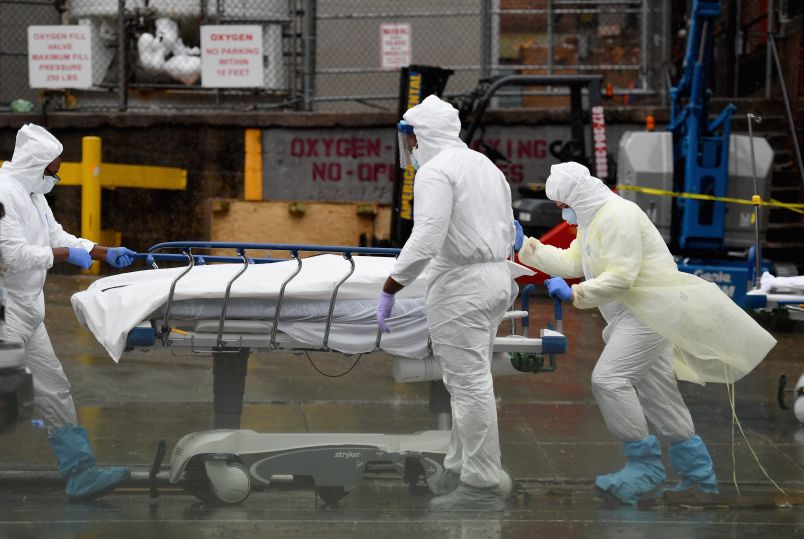One year into the pandemic, much of what we think we know about the number of people who have died may be wrong.
The country has been devastated by more than 500,000 COVID-19 deaths. Over the course of 2020, researchers sought to determine how much higher the death toll was than the official count. Thousands of people had potentially lost their lives due to what was understood to be indirect deaths associated with the pandemic — missed doctor’s appointments, overflowing emergency rooms, unemployment and months of isolation.
But a new approach for estimating the true death toll in the U.S. — the number of deaths beyond what would have been expected over the past 12 months — suggests that a smaller proportion of Americans have died from indirect, pandemic-related reasons over the past year than previously thought.
The new estimate takes into account the aging U.S. population, finding that the virus hit as the population of elderly Americans expanded in 2020 — an echo of the post-World War II baby boom.
“The population is aging every week,” Dr. Jeremy Faust, an emergency physician at Brigham and Women’s Hospital and an instructor at Harvard Medical School told TPM. “You don’t want to make the mistake of looking at a six-month period and assuming that the population is the same on day zero as it is on day 180.”
The research could mean that the virus’s national death toll — around 516,000 as of this writing — accounts for the vast majority of those who died. It challenges theories that posited that indirect deaths associated with the pandemic account for as much as an extra one-third of deaths in 2020 on top of those caused by the virus.
It’s an important shift that could signal a sea change in how public health researchers calculate excess mortality, the measurement of how many people actually died over a given period of time compared to how many people were expected to die.
‘Now-casting’
Excess death calculations rely on creating a baseline estimate of how many people are expected to die over a given time period.
The upward departure from that baseline estimate of predicted deaths makes up the excess death estimate: the number of people who died beyond what was expected.
In theory, this captures all the people who die as a result of a given event. In the case of the pandemic, it includes both people killed by the virus and also those who passed away due to indirect but pandemic-related causes, like overworked doctors and isolation.
But, Faust argued, these excess death estimates must rely not only on observing how many people died in a catastrophic year like 2020.
They also rely on what he called “now-casting”; the art of determining what would have happened to the country’s mortality rate over the past twelve months absent the pandemic.
Conflicting estimates
The sea change in how researchers “now-cast” the baseline national death rate started with a study released in December by Dr. Meredith Shiels of the National Cancer Institute.
Shiels’ paper demolished the standard estimate of excess mortality during the pandemic. Previous studies had found that the virus only accounted for two-thirds of all excess deaths during the pandemic, leaving a huge death toll uncaptured by official figures. But Shiels found that if one took into account the increased average death rate of an aging population, that number shrunk.
In short: you can’t accurately estimate the true toll of the pandemic — direct and indirect deaths from the virus — if you forget that the country is aging rapidly.
And though right-wing pundits raging against lockdowns have posited that the disruption and isolation from the pandemic control measures caused a tsunami of indirect deaths, the data from Shiels’ study suggests that COVID-19 itself may account for nearly all of the excess deaths in 2020.
Shiels provides the hard numbers in her paper. America’s population in 2020, for example, included more than 5 million more people older than 65 than the country did between 2015 and 2019.
That, Faust argued, significantly ups the number of people predicted to die over the past twelve months, pandemic or not.
‘Disgusting Darwinism’
As Baby Boomers got older, the country’s death rate was bound to increase regardless of the virus.
But what the research illuminates is something that’s been known since the pandemic’s earliest days: that the aging U.S. population was uniquely primed for a pathogen that targets the elderly. Not only have excess death estimates which found that a huge amount of people died of indirect causes associated with the pandemic been wrong, but the true number reflects the tragedy that’s befallen the country’s elderly.
Maria Polyakova, an assistant professor at the Stanford University School of Medicine, told TPM that some excess death calculations could suggest that 2020 presented an unusually vulnerable group for the virus.
“These people are close to the end of life, and so they’re really, really vulnerable to any infection or virus,” she added. “And so it pushes the death to happen earlier.”
Faust described it as a “disgusting Darwinism.” Older people who might have lived for five or ten more years after 2020 were killed by the virus.
“In the U.S., we haven’t had a sustained period of excess mortality like this since 1918,” Faust told TPM. “We’re trying to measure something that hasn’t happened in a very long time.”



